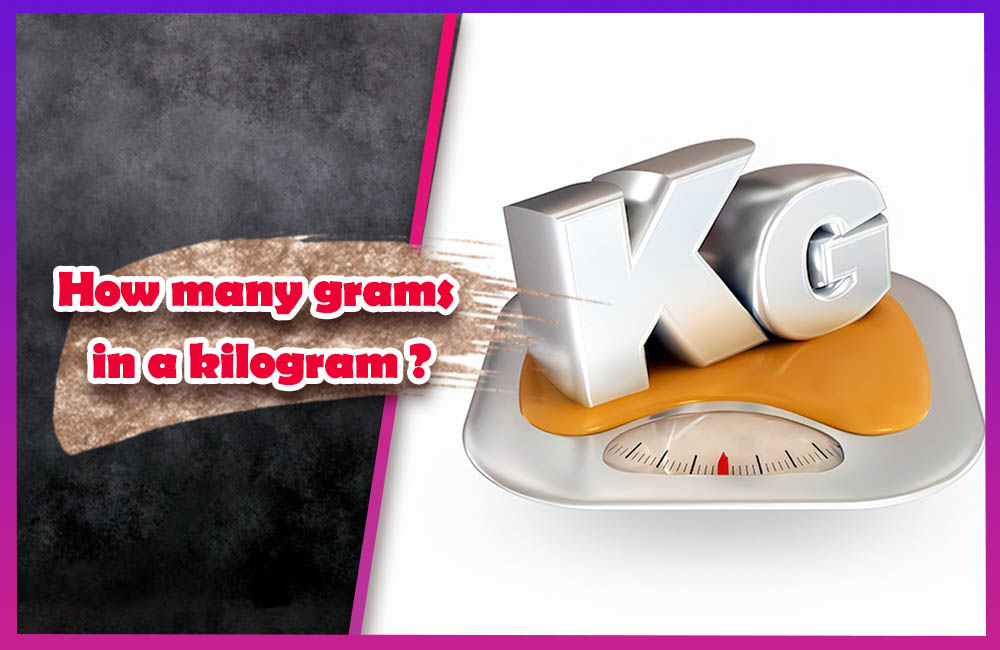For those looking to learn more about the international system of measurement, one essential question stands out: how many grams in a kilogram? The metric system can be complicated and confusing, but luckily there is an easy answer to this seemingly tricky puzzle.
By understanding the common base units found within the metric system, you can navigate these concepts with ease. We will explore all of the important details surrounding grams and kilograms – from conversion factors to real-world examples – so you’ll never again struggle figuring out how many grams are in a kilogram!
How many grams in a kilogram
Table of Contents
A kilogram is a unit of mass in the metric system and it is equal to 1,000 grams. This relationship between kilograms and grams can be broken down further into smaller units. For example, one kilogram equals 1000000 milligrams (mg) or 1000 decagrams (dg). Likewise, one gram equals 1000 milligrams (mg) or 0.001 kilograms (kg).
To illustrate this relationship between kilograms and grams:
1. One kilogram of apples would have a mass of approximately 1,000 grams.
2. A box of chocolates that weighs 500 grams would weigh 0.5 kilograms.
3. A large bag of flour that has 4 kilograms would have a mass of 4000 grams. It is important to be able to convert between kilograms and grams in order to accurately calculate the mass of an object or substance. By understanding this relationship, it will help ensure that measurements are taken correctly.
What Is a gram?
A gram is a unit of measurement for mass, weight, or volume. It is the base metric unit for measuring these physical properties and originated in France during the late 18th century. The term comes from the Greek word “gramma”, meaning “weight”. Examples Of Grams: 1. A gram is commonly used to measure the mass of objects.
For example, one liter of water weighs roughly 1 kilogram (1000 grams). Likewise, a single apple might weigh around 200 grams depending on its size and type.
2. Grams are also used to measure other types of materials such as liquids, powders or gases. For instance, a liter of milk usually weighs around 1 kg (1000 g). Similarly, a liter of nitrogen typically weighs 1.25 kg (1250 g).
3. Grams can be used to measure the volume of a substance. For example, a teaspoon of sugar is 5 grams and a tablespoon is 15 grams.
What Is a kilogram?
A kilogram (kg) is a metric unit of measurement for mass or weight. It is the base unit of mass in the International System of Units (SI). A kilogram is equal to 1000 grams, or 2.2 pounds.
Examples Of Kilograms:
1. One of the most common uses for kilograms is in food measurements. For instance, a small banana typically weighs around 100g (0.1kg) while a large one can weigh up to 200g (0.2kg).
2. Kilograms are also used in everyday weights such as clothing and luggage allowances on planes and trains. For example, most airlines typically allow passengers to carry up to 10 kg per person as hand baggage.
3. Kilograms can be used to measure the weight of many larger items too, such as furniture pieces and vehicles. For instance, the weight of an average car is usually around 1500 kg.
How to convert kilograms to grams
Kilograms and grams are two units of measurement used to measure mass. To convert kilograms to grams, simply multiply the number of kilograms by 1000. For example, if you want to convert 5kg into grams, multiply it by 1000 which equals 5000g.
Fomula: Kilograms x 1000 = Grams
Examples:
1. Convert 10 kilograms to grams: 10 kg x 1000= 10000g
2. Convert 0.5 kilograms to grams: 0.5 kg x 1000 = 500g
3. Convert 4 kilograms to grams: 4 kg x 1000 = 4000g
Read more:
How many tablespoons in 1/3 cup
How many tablespoons in 1/4 cup
How many tablespoons in an ounce?
Real life applications of kilogram and gram

Here are some real-life applications of kilograms and grams:
1. Food – Kilograms and grams are often used to measure the mass of food items such as fruit, vegetables, grains, and other groceries. For example, a loaf of bread typically weighs around 750g (0.75kg). Likewise, a bag of sugar can weigh up to 1kg (1000g).
2. Clothing – Kilograms and grams are also useful when measuring the weight of clothing items such as jackets, coats or shoes. For instance, an average pair of sneakers usually weighs between 400-500g (0.4 – 0.5 kg).
3. Medicine – Medical professionals use kilograms and grams to measure the mass of medicines such as tablets or capsules. For example, a capsule of paracetamol typically weighs around 500mg (0.5g). Similarly, an ibuprofen tablet can weigh up to 400mg (0.4g).
4. Animals – Vetenarians often use kilograms and grams to measure the bodyweight of animals, such as cats and dogs. For instance, an adult cat generally weighs between 2-6kg (2000 – 6000g).
5. Luggage – When travelling by plane or train, kilos and grams are often used to measure the weight of luggage for hand and checked baggage allowances. For example, most airlines allow passengers to carry up to 10kg per person as hand luggage.
5 Most importance of units of measurement kilogram and gram in cooking:
1. Accurate Measurement: The most important reason for using kilograms and grams in cooking is to measure ingredients accurately. For instance, when baking a cake, it is vital that the recipe calls for the exact amount of sugar, flour and other ingredients as specified in order to get the best results.
2. Consistency: Using units of measurement such as kilogram or gram also helps ensure consistent results with every batch of food you make. This is particularly important if you are serving large groups of people or catering an event.
3. Portion Control: Measuring food portions with kilos and grams can help keep track of calorie intake, which can be beneficial for those trying to manage their weight or stick to a healthy diet.
4. Cost Savings: Knowing how much of each ingredient is needed helps to avoid over-purchasing or wasting food, which can ultimately save you money in the long run.
5. Food Safety: Measuring ingredients with kilos and grams also ensures that food is correctly prepared and cooked, which helps reduce the risk of foodborne illnesses caused by undercooked or contaminated food items.
FAQ about how many grams in a kilogram:
How much does 1 kg weigh?
One kilogram weighs 2.20462262 pounds, or about 35 ounces.
What is the symbol for kilogram?
The symbol for kilogram is “kg”.
Is a gram heavier than a kilogram?
A gram is much lighter than a kilogram. One gram weighs 0.001 kg while one kilogram weighs 2.20462262 pounds or 35 ounces.
How many tablespoons are in 1 kg?
There are 200 tablespoons in 1 kg of sugar, flour, and other dry ingredients.
How many milligrams are there in 1 kg?
There are 1,000,000 milligrams in 1 kg.
How many ounces are there in a kilogram?
There are 35.2739619 ounces in one kilogram.
What is the difference between grams and kilograms?
The main difference between grams and kilograms is that 1 gram is equal to 0.001 kg while 1 kg is equal to 1000 grams.
Does a kilogram weigh the same as a pound?
A kilogram weighs approximately 2.2 pounds, or around 35 ounces. However, this conversion does not take into account any density or buoyancy factors that may be affected by the type of substance being weighed.
How many cups are in 1 kilogram?
Depending on the specific ingredient, there can be anywhere between 2 and 4 cups in one kilogram. For example, one cup of all-purpose flour is typically equal to 125 grams, so 8 cups would make up 1 kg.
What is a gram used for?
Grams are used in the metric system for measuring weight and mass. They are often used to weigh out ingredients in cooking, or measure out portions of food.
Is a gram smaller than an ounce?
Yes, a gram is much smaller than an ounce. One gram weighs 0.035 ounces while one ounce weighs 28 grams.
How many kilograms are there in 5 pounds?
There are 2.26796185 kilograms in 5 pounds. To convert this amount, multiply 5 by 0.45359237 to get the result of 2.26796185 kg.
How do you convert kilograms to pounds?
To convert from kilograms to pounds, simply multiply the number of kilograms by 2.20462262. For example, if you have 3 kg, you would multiply 3 by 2.20462262 to get 6.61 pounds.
What is a kilogram used for?
Kilograms are commonly used for measuring weight and mass as well as food. It can also help with measuring liquids such as water or oil in large batches. Additionally, they are often used in medical settings to measure body weight accurately and monitor changes over time.
Conclusion about how many grams in a kilogram:
Measuring food and ingredients by weight with kilos and grams is not only important for accuracy but also helps maintain consistency, control portions, save costs and ensure food safety. With this guide, you now have a better understanding of how many grams are in a kilogram and the benefits of using it when cooking.

I’m Leon Todd and my passion for cooking is my life goal. I’m the owner and operator of Davieschuckwagon.com, a website that specializes in providing high-quality cooking information and resources. I love to experiment with new flavors and techniques in the kitchen, and I’m always looking for ways to improve my skills.
I worked my way up through the ranks, taking on more challenging roles in the kitchen. I eventually became a head chef.
Cooking is more than just a job to me – it’s a passion that I want to share with the world.

